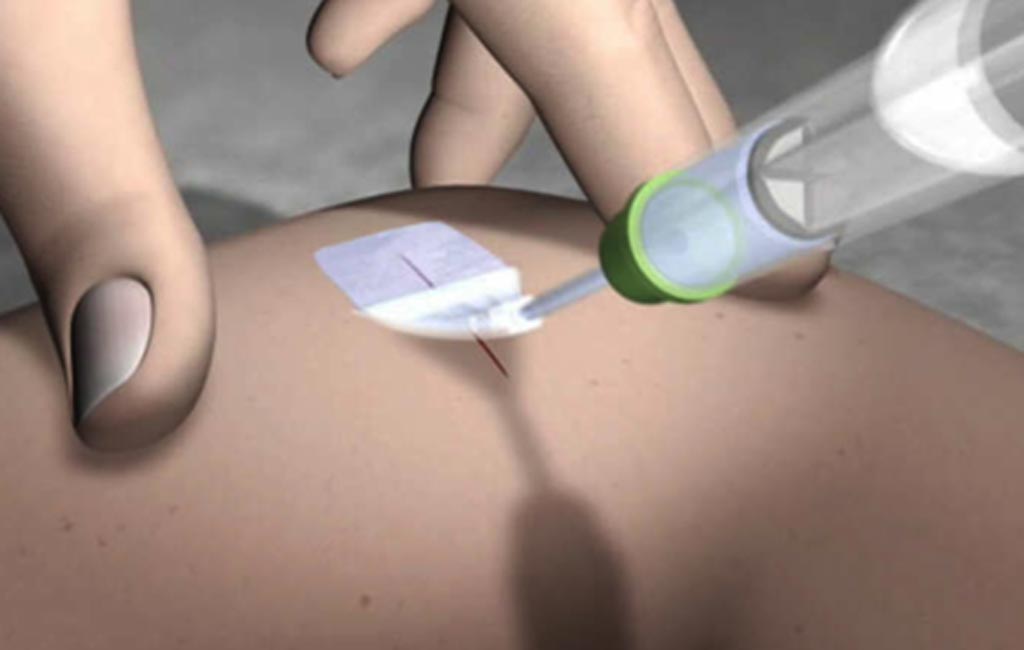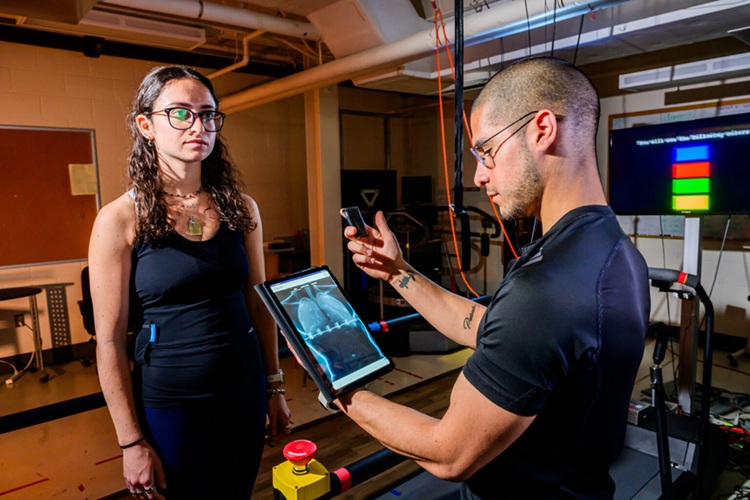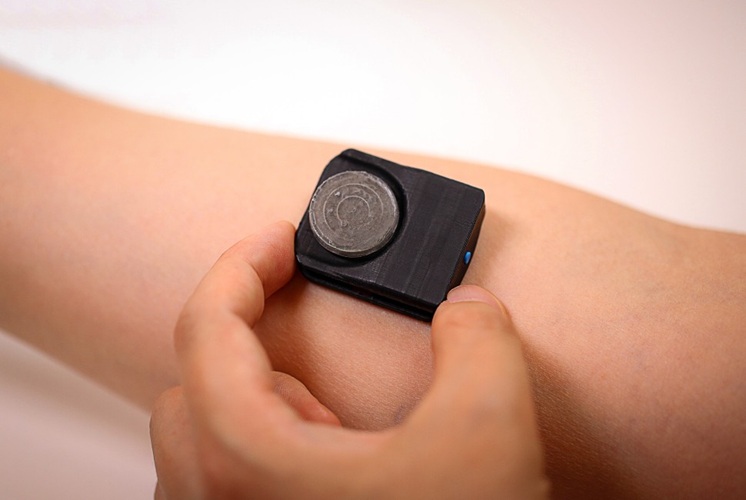Topical Skin Adhesive Closes Surgical Incisions
|
By HospiMedica International staff writers Posted on 07 Feb 2018 |

Image: A polyurethane surgical adhesive closes surgical sites (Photo courtesy of Grünenthal).
A novel skin adhesive that offers robust bonding strength, fast sealing, and high flexibility offers an alternative to traditional wound closing techniques.
The Grünenthal (Aachen, Germany) Flix adhesive is a polyurethane-based, ready-to-use surgical sealant with a unique set of features that allow its use in a broad variety of application areas. These include high-strength adhesiveness to ensure safe wound closure until the wound healing is completed; a honey-like viscosity that allows for an easy and targeted application; and a biocompatible composition that causes no exothermic reaction, itching, or redness, thus providing the basis for good cosmetic results and maximum patient comfort.
Flix has two main components, provided pre-packaged in a two-chambered syringe; an entirely synthetic polyurethane prepolymer, which is functionalized with reactive isocyanate groups, and an amino-based curing agent. A poly-addition reaction begins as soon as the components are mixed in the syringe’s static mixing unit. Once mixed, application of the product generates a transparent film that is easily applied to the injured tissue. The components cure quickly, adhering to the tissue via both mechanical and physical adhesion.
The syringe’s spreader tip also allows for a broad and targeted application over the wound site. Once in place, a strong polymer network is quickly formed and full polymerization is completed within a few minutes. As Flix comes prepackaged as a single-use two-chamber syringe, application can be completed in less than 60 seconds; this permits near-instant instant use, even in the case of emergencies. In addition, the adhesive can be stored at room temperature, obviating thawing or preparation prior to use.
“With devices and technologies like surgical sealants we broaden our portfolio beyond the development of new chemical entities in focus areas of high unmet medical need, that is pain and inflammation,” said Gabriel Baertschi, CEO of Grünenthal. “We believe Flix will provide an innovative alternative to traditional wound closing techniques. Through its high flexibility it may enhance patient comfort after surgery.”
Related Links:
Grünenthal
The Grünenthal (Aachen, Germany) Flix adhesive is a polyurethane-based, ready-to-use surgical sealant with a unique set of features that allow its use in a broad variety of application areas. These include high-strength adhesiveness to ensure safe wound closure until the wound healing is completed; a honey-like viscosity that allows for an easy and targeted application; and a biocompatible composition that causes no exothermic reaction, itching, or redness, thus providing the basis for good cosmetic results and maximum patient comfort.
Flix has two main components, provided pre-packaged in a two-chambered syringe; an entirely synthetic polyurethane prepolymer, which is functionalized with reactive isocyanate groups, and an amino-based curing agent. A poly-addition reaction begins as soon as the components are mixed in the syringe’s static mixing unit. Once mixed, application of the product generates a transparent film that is easily applied to the injured tissue. The components cure quickly, adhering to the tissue via both mechanical and physical adhesion.
The syringe’s spreader tip also allows for a broad and targeted application over the wound site. Once in place, a strong polymer network is quickly formed and full polymerization is completed within a few minutes. As Flix comes prepackaged as a single-use two-chamber syringe, application can be completed in less than 60 seconds; this permits near-instant instant use, even in the case of emergencies. In addition, the adhesive can be stored at room temperature, obviating thawing or preparation prior to use.
“With devices and technologies like surgical sealants we broaden our portfolio beyond the development of new chemical entities in focus areas of high unmet medical need, that is pain and inflammation,” said Gabriel Baertschi, CEO of Grünenthal. “We believe Flix will provide an innovative alternative to traditional wound closing techniques. Through its high flexibility it may enhance patient comfort after surgery.”
Related Links:
Grünenthal
Latest Surgical Techniques News
- Intravascular Imaging for Guiding Stent Implantation Ensures Safer Stenting Procedures
- World's First AI Surgical Guidance Platform Allows Surgeons to Measure Success in Real-Time
- AI-Generated Synthetic Scarred Hearts Aid Atrial Fibrillation Treatment
- New Class of Bioadhesives to Connect Human Tissues to Long-Term Medical Implants
- New Transcatheter Valve Found Safe and Effective for Treating Aortic Regurgitation
- Minimally Invasive Valve Repair Reduces Hospitalizations in Severe Tricuspid Regurgitation Patients
- Tiny Robotic Tools Powered by Magnetic Fields to Enable Minimally Invasive Brain Surgery
- Magnetic Tweezers Make Robotic Surgery Safer and More Precise
- AI-Powered Surgical Planning Tool Improves Pre-Op Planning
- Novel Sensing System Restores Missing Sense of Touch in Minimally Invasive Surgery
- Headset-Based AR Navigation System Improves EVD Placement
- Higher Electrode Density Improves Epilepsy Surgery by Pinpointing Where Seizures Begin
- Open-Source Tool Optimizes Placement of Visual Brain Implants
- Easy-To-Apply Gel Could Prevent Formation of Post-Surgical Abdominal Adhesions
- Groundbreaking Leadless Pacemaker to Prevent Invasive Surgeries for Children
- Spectroscopy Technique Improves Surgery for Pediatric Epilepsy Patients
Channels
Critical Care
view channel
Novel Intrabronchial Method Delivers Cell Therapies in Critically Ill Patients on External Lung Support
Until now, administering cell therapies to patients on extracorporeal membrane oxygenation (ECMO)—a life-support system typically used for severe lung failure—has been nearly impossible.... Read more
Generative AI Technology Detects Heart Disease Earlier Than Conventional Methods
Detecting heart dysfunction early using cost-effective and widely accessible tools like electrocardiograms (ECGs) and efficiently directing the right patients for more expensive imaging tests remains a... Read more
Wearable Technology Predicts Cardiovascular Risk by Continuously Monitoring Heart Rate Recovery
The heart's response to physical activity is a vital early indicator of changes in health, particularly in cardiovascular function and mortality. Extensive research has demonstrated a connection between... Read more
Wearable Health Monitoring Device Measures Gases Emitted from and Absorbed by Skin
The skin plays a vital role in protecting our body from external elements. A key component of this protective function is the skin barrier, which consists of tightly woven proteins and fats that help retain... Read morePatient Care
view channel
Portable Biosensor Platform to Reduce Hospital-Acquired Infections
Approximately 4 million patients in the European Union acquire healthcare-associated infections (HAIs) or nosocomial infections each year, with around 37,000 deaths directly resulting from these infections,... Read moreFirst-Of-Its-Kind Portable Germicidal Light Technology Disinfects High-Touch Clinical Surfaces in Seconds
Reducing healthcare-acquired infections (HAIs) remains a pressing issue within global healthcare systems. In the United States alone, 1.7 million patients contract HAIs annually, leading to approximately... Read more
Surgical Capacity Optimization Solution Helps Hospitals Boost OR Utilization
An innovative solution has the capability to transform surgical capacity utilization by targeting the root cause of surgical block time inefficiencies. Fujitsu Limited’s (Tokyo, Japan) Surgical Capacity... Read more
Game-Changing Innovation in Surgical Instrument Sterilization Significantly Improves OR Throughput
A groundbreaking innovation enables hospitals to significantly improve instrument processing time and throughput in operating rooms (ORs) and sterile processing departments. Turbett Surgical, Inc.... Read moreHealth IT
view channel
Printable Molecule-Selective Nanoparticles Enable Mass Production of Wearable Biosensors
The future of medicine is likely to focus on the personalization of healthcare—understanding exactly what an individual requires and delivering the appropriate combination of nutrients, metabolites, and... Read more
Smartwatches Could Detect Congestive Heart Failure
Diagnosing congestive heart failure (CHF) typically requires expensive and time-consuming imaging techniques like echocardiography, also known as cardiac ultrasound. Previously, detecting CHF by analyzing... Read moreBusiness
view channel
Expanded Collaboration to Transform OR Technology Through AI and Automation
The expansion of an existing collaboration between three leading companies aims to develop artificial intelligence (AI)-driven solutions for smart operating rooms with sophisticated monitoring and automation.... Read more















